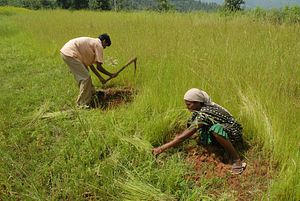Protests originally spearheaded by farmers in the states of Maharashtra and Madhya Pradesh in India have turned into a broader phenomenon that has spread to other states over the past two weeks. On June 21, during International Yoga Day, for the second time ever, demonstrating farmers made their way to the capital over the past few months. As political leaders celebrated Yoga, farmers in several states, on highways and roads, performed the ‘shavasana’ (sleeping position) to impress upon the public a symbol of death and to bring attention to the plight of farmers suffering from indebtedness. An overview of the protest as it unfolded and an examination of their demands indicates that unless New Delhi is able to provide a committed and sustainable solution, these protests might not abate ahead of the monsoon season.
Beginning as a response to a significant fall in the prices of onions and legumes, farmers in Maharashtra and Madhya Pradesh began a protest calling for better prices. In the Mandsaur area of western Madhya Pradesh, these protests turned violent in their calls for loan waivers and government commitments towards the long-term alleviation of rural indebtedness and distress through the institution of policies like a minimum support price for produce. Resorting to destructive strategies, allegedly including arson and even targeting public transport, the discontent reached fervor, causing the government to dispatch paramilitary forces to quell the disruption. Five were killed when the police opened fire, and another succumbed to injuries later that week. A curfew was imposed in Mandsaur and internet services were reportedly suspended in areas as well.
While the BJP-led government in Maharashtra offered a sweeping and almost total loan waiver to marginal farmers and those who had an established pattern of attempts at loan repayment, the move seems to have been a mere band aid for a much larger problem. In Madhya Pradesh, the BJP government responded by firmly denying the possibility of waivers as the state already offered loans at zero percent interest rates and even subsidies on loans. Congress party leaders used this opportunity to call the government out for inaction, terming their tenure as dictatorial. While a Congress legislator who was caught on camera inciting mob violence was arrested, in the meantime, the party announced that it was organizing a farmers’ solidarity strike for 72 hours. Chief Minister Shivraj Singh Chouhan on the other hand announced that he was going on a fast in an attempt to secure peace.
The farming community, which saw a spate of suicides in both 2016 and 2017, decided to intensify its demonstrations in the wake of two more suicides during the protests. Activists in the state placed a demand for an inquiry into the deaths, in addition to calls for loan waivers. An organization of 62 farmers’ bodies announced a blockade of national highways on June 16. Arguing that the central government had taken no concentrated steps to respond to their protests, the group reminded the BJP of its electoral promises that assured them a 50 percent profit over their input costs. The three main demands of this protest included loan waivers, implementation of the Swaminathan Commission’s report that discussed profitable crop prices, and, in some pockets, and a revocation of the ban on animal slaughter that added to dwindling sources of livelihood.
Farmers in Haryana, Rajasthan, and parts of Gujarat joined this massive protest, as each government attempted to amp up security and curtail possible violence. Farmers in Haryana have further announced a plan to head to the capital to storm the office of the Niti Aayog, which bears the responsibility for formulating policy on July 3 and begin an indefinite demonstration from Jantar Mantar the same day. The death toll rose to 17 as on June 21, in the meanwhile, as suicides in Madhya Pradesh increased.
While loan waivers, which have already been granted by three states, provide an immediate solution to the distress of farmers, the call for more serious long-term redress is far more important. One such step might be the institution of more streamlined input prices, such as through a minimum support price system that allows the government to provide a guarantee to farmers at a certain level of income. However, already critics have pointed out that this will open up the possibility of shifting government responsibility to the private sector, rendering it an unsustainable solution in the long run.
The onus now falls upon the BJP to not just bring these protests to a halt, but to do so in a manner that won’t spark off a reprisal in the near future. These protests are a glaring reminder of electoral promises that the party could not live up to. Additionally, estimations indicate that demonetization and the cash crunch that followed severely worsened the farmers’ ability to get back on their feet. On both these counts, the BJP has faced backlash from significant vote banks that cut across even the states where they are in power. While successive governments have dropped the ball on sustainable agrarian reform to counter indebtedness, the costs to the BJP this time may prove more fatal than to the others. Deflecting the issue and waiting for it to abate on its own does not seem like a plausible solution this time.

































